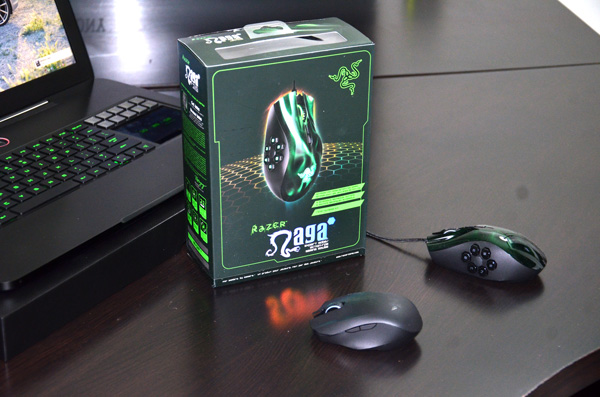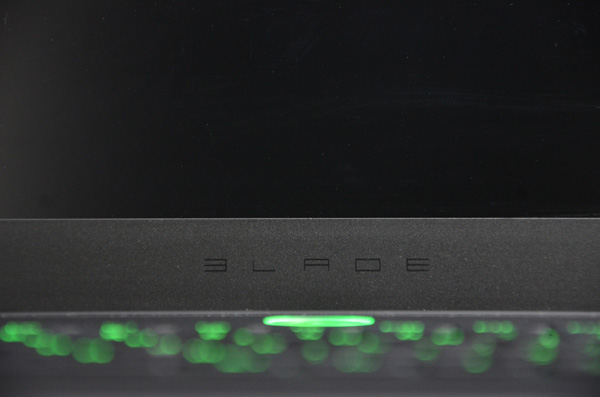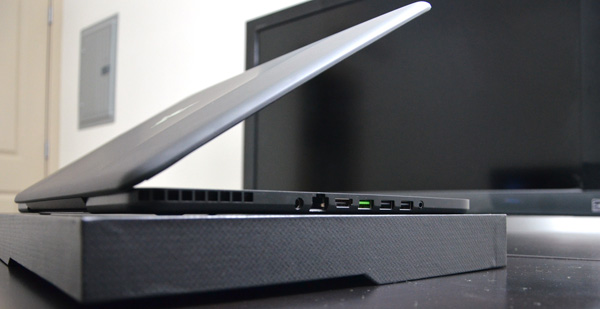The Razer Blade Review
by Vivek Gowri & Jarred Walton on March 15, 2012 3:01 AM ESTRazer is, first and foremost, a gaming company. From the company slogan (“By gamers, for gamers”), to partnerships with a number of the most popular game development studios, even the job title on the CEO’s business card (it reads Chief Gamer), nothing about Razer is shy about who the target market is. But it’s key to note that Razer is a gaming company which has focused on gaming-related peripherals and accessories—mice, keyboards, headsets, controllers, and limited edition peripherals for specific games. But that all changes as of now.
The vessel of change in question: Razer’s new Blade, a $2799 gaming laptop that bucks almost all of the common trends in gaming-focused desktop replacements. This isn’t the first time that Razer has shown intent to play in the gaming hardware space, having shown off the innovative Switchblade concept system at CES 2011. The Switchblade design concept clearly had a major influence on the Blade as is evident from the Switchblade UI panel on the side of the keyboard, but what’s important to note with the Blade is that it shows just how serious Razer is about transitioning into PC hardware and gaming systems. Read on to see how it fared.
| Razer Blade Specifications | |
| Processor |
Intel Core i7-2640M (2x2.80GHz + HTT, Turbo to 3.5GHz, 32nm, 4MB L3, 35W) |
| Chipset | Intel HM67 |
| Memory | 2x4GB DDR3-1333 |
| Graphics |
NVIDIA GeForce GT 555M 2GB GDDR5 (144 CUDA Cores, 675MHz/1350MHz/2.5GHz core/shader/memory clocks, 128-bit memory bus) |
| Display |
17.3" LED Matte 16:9 1080p AUO B173HW01 V5 |
| Hard Drive(s) | 256GB Lite-On LET-256M2S 6Gbps SSD |
| Optical Drive | - |
| Networking |
Intel Centrino Advanced-N 6230 802.11a/b/g/n Bluetooth 3.0 |
| Audio |
Realtek ALC275 HD Audio Stereo speakers Single combination mic/headphone jack |
| Battery | 6-Cell, 60Wh (integrated) |
| Front Side | - |
| Right Side | Kensington Lock |
| Left Side |
AC Adaptor Port Gigabit Ethernet HDMI USB 3.0 2 x USB 2.0 Headphone/Line-in Combo |
| Back Side | - |
| Operating System | Windows 7 Home Premium 64-bit SP1 |
| Dimensions |
16.81" x 10.90" x 0.88" (WxDxH) 427mm x 277mm x 22.4mm |
| Weight |
6.4 lbs 2.91kg |
| Extras |
2.0MP Webcam Ambient light sensor Backlit keyboard Switchblade UI Ten dynamic LCD keys 4.05" WVGA LCD touchpad (capacitive, multitouch) |
| Warranty | 1-year limited |
| Pricing | $2799 |
Heralded by Razer as the “World’s First True Gaming Laptop”, the 17” Blade is built around Intel’s Core i7-2640M and an NVIDIA GT 555M dGPU. The i7 is clocked at 2.8GHz, with a max turbo of 3.3GHz on two cores or 3.5GHz on a single core, while the GT 555M has 2GB of vRAM and clocks of 675/1350/2500 MHz for core, shaders, and vRAM, respectively. The GPU is pretty pedestrian by 17” gaming notebook standards, with the GT 555M falling somewhere between high-end mainstream and low-end gaming cards. There’s many different versions of the GT 555M, but the SKU in the Blade seems to be the most potent variant, using a cut down version of the same GF116 architecture in the GTX 560M. The rest of the specsheet is headlined by 8GB of memory and a 256GB SSD made by Lite-On. The Lite-On LET-256M2S is built around Marvell’s 88SS9174 controller, the same controller that serves as the basis for Intel’s SSD 510. Lite-On claims up to 480MB/s for sequential read and 330MB/s for sequential write speeds. The display is a 17.3” 1080p panel made by AU Optronics, but what we were most thrilled by is the beautiful matte screen finish. The Switchblade UI panel lives to the right of the keyboard and features 10 dynamic LCD keys (Art Lebdev-style) as well as a secondary display, a 4.05” 800x480 multitouch LCD that serves as the Blade’s touchpad. In addition, Razer includes a special edition of their Bluetooth mobile gaming mouse, the Orochi.
Rather impressively, Razer managed to pack all that hardware into an enclosure that’s just 0.88” thick and weighs 6.4lbs. If Intel were to extend the ultrabook hardware guidelines out to 17” notebooks, the Blade would hit them pretty dead on. The razor-thin (get it, get it?) profile explains why Razer was limited to a GT 555M—simply put, Razer couldn’t fit anything more powerful into the thermal design without significantly compromising the performance of the cooling system. But what’s noteworthy here is that Razer took the design of the Blade in completely the opposite direction of the majority of the gaming notebook world.
If you were to poll a large group of people for the best 17-18” gaming class portable on the market, you’d end up with a range of answers—Alienware’s M17x or M18x, the ASUS G74Sx, some variant of Clevo’s P170HM, possibly the MSI GT780, etc.
| Razer Blade | Alienware M17x R3 | Alienware M18x | ASUS G74SX | Clevo P170HM | MSI GT780-DXR | |
| CPU | Core i7-2640M | Core i7-2670QM | Core i7-2670QM | Core i7-2670QM | Core i7-2670QM | Core i7-2670QM |
| GPU | GT 555M | HD 6990 | GTX 560M SLI | GTX 560M | GTX 580M | GTX 570M |
| Thickness | 0.88" | 1.76" | 2.13" | 0.82-2.44" | 1.65-1.89" | 2.17" |
| Weight | 6.40lbs | 9.39lbs | 11.93lbs | 9.42lbs | 8.60lbs | 8.63lbs |
| Price | $2799 | $2049 | $2899 | $1399 | $2239 | $1699 |
Take a look at the spec table—the Blade is thinner than everything up there by at least a factor of two, as well as being at least two pounds lighter. It’s also a good deal more expensive than everything but the M18x, and a good deal less powerful. (It's worth noting that the Blade is the only one on the list with an SSD, but otherwise they're pretty similar—1080p, 8-12GB memory, etc. Factor an additional $200 to upgrade to an SSD in the other systems.) Comparing the M18x and the Blade head to head is a bit of comedy—in terms of form factor, the Blade is literally half the laptop the nearly twelve-pound M18x is. They’re both very high-end and very expensive gaming notebooks, but they couldn’t be any more different after that.
So it’s pretty clear that Razer wasn’t aiming at the gaming notebook establishment—in fact, on paper the Blade looks a bit like the Windows answer to the 17” MacBook Pro. Which isn’t to say that the 17” MBP is a competitor for the Blade in any way—the design ethos and target markets are completely different, but it’s worth noting the similarities in form factor and price, as well as the focus on premium design and overall attention to detail. In the PC world, the closest you’re going to get on paper is the HP ENVY 17, at 1.28” thick, 7.37lbs, and starting at $1249 with AMD Radeon HD 7690 XT graphics.
Where I’m going with all this is to show that the Blade is a pretty unique proposition in the notebook world—it’s a high-end 17” gaming portable that, at least in terms of hardware, focuses more on the portable than the gaming.













95 Comments
View All Comments
niva - Thursday, March 15, 2012 - link
That system is indeed interesting. I'm really looking forward to seeing what other machines they'll put out in the future. I'm not interested in the Switchblade, but the design of this machine highly appeals to me. The usage of the black and green details, the glowing kb... very nice Razer. Now I wish I could afford something like this...Thefinaleofseem - Friday, March 16, 2012 - link
The most hilarious thing about this laptop? It's arguably more overpriced than a 17" Macbook Pro. Compare the specs. 6770M vs 555M. They're about the same. 1080p panels with the MBP arguably having a better panel, similar form factors and weight. The Blade actually went with a bloody dual core when the MBP has a quad that turbos to about the same frequency anyway. It does have an SSD, which is a welcome change over the laughable 320GB hard drive they used to have in there and actually gives it a solid edge. It does have 8GB of RAM, although if you buy RAM anywhere other than Apple, you can get 8GB for less than $40, so that's hardly an issue.That leaves the little touchpad and a few extra buttons. Sorry, but that screen is little more than a gimmick. A touchpad with no tactile feedback? Utterly useless in gaming, which is the market that Razer is looking to grab with this thing. Have fun looking away from the screen periodically to ensure that your fingers are in the right place. It might be somewhat useful in slower/turn-based games, but nothing even remotely fast paced will have a use for it.
The only solid advantage it has is the SSD. The major disadvantage it has is the laughable dual core CPU. Really, in a game that can use perhaps only two cores, the difference will be minute if it's even visible at all. In games that can use a quad? The MBP will pull ahead easily, not to mention if you're running multiple other applications with your games or want to do something else, like media compression. That leaves the SSD, which is nice, but quite frankly, when you're about on the level of what many consider to be the poster boy for overpriced, then maybe you're charging too bloody much.
santiagodraco - Sunday, March 18, 2012 - link
I agree with much of what's you've said and also agree that this thing has missed it's mark (but as a notebook per se it's very cool).As for the trackpad... well that's really a non issue as anyone who calls themselves a gamer wouldn't be caught dead using a trackpad, they'll have a mouse in the bag. So from that perspective the trackpad is very cool as an information display but nothing else.
Hrel - Thursday, March 15, 2012 - link
How can you claim to be about gamers when you put a GT540 in a 17" Chassis? Psh, doesn't even count. With that price tag I expected AT LEAST a GTX560, if not GTX570. Don't get me wrong, I like the idea of trying to make this type of laptop less cumbersome. But right now I can't imagine playing on anything less than the GTX560M, which I have currently in my Clevo. Overall I'm very happy with it, but I'd pay an extra 500 bucks to have a second hdd bay and cut the bulk by half. As for the specs this is as low as I'm willing to go. Get rid of the cd rom drive, fine. I honestly couldn't care any less about that. But the GT540M is unacceptable; I'm sorry. It's nice that this is thin, but I'll put up with a little extra bulk and weight to have a GPU I can actually use. If you have to do that by putting the GPU in an external "caddie" or docking station I'm fine with that too. As I don't ever game on battery power, only when it's plugged in.Razer, I say develop a docking station using Intels lighpeak connection and some good ol USB 3.0, and make that dock compatible with every single laptop you release, period. THAT! My friends will garner some serious customer loyalty.
Hrel - Thursday, March 15, 2012 - link
I look forward to the day when I can just slide my smartphone into my laptop, where that touchpad is now. One concern though, I have a friend who because of a skin condition cannot use anything that's capacitive touch. I'm sure this is a small segment of their target customers but every time I see capacative touch on stuff I think of that now.Hrel - Thursday, March 15, 2012 - link
hm, see that's another things, especially for this much money, I expect to work properly. Noise, I never notice the noise of my Clevo P151. If I listen for it I can hear it, but I do not ever notice it. I paid 1100 bucks for this thing, then put a Seagate Hyrbrid drive in it. Beautiful 1080p screen. For nearly 3 times that I expect everything to be better in every single way. The physical size of the laptop just doesn't matter if it means sacraficing anything else at all about the laptop. I'd rather have a 20lb monster that runs everything I play at 1080p and doesn't make a peep than a 6lb pansy that can't even play Mass Effect 1 at 1080p smoothly. Like the SSD, ok, load times are low. That's nice. That's why I have the hybrid drive. But really I care much more about the performance IN THE application that I do how long it takes to load that application. It's a luxury item, like the size of the laptop, nice to have and I'm one of those people who are willing to pay extra for that kind of thing; I have the means. I'm just not willing to sacrafice another area of the laptop to get it. I do like the design elements and apparent attention to detail quite a lot. This looks like an excellent first try, they just got too ambititious and sacraficed on fundamentals; in my opinion. Also the price seems about 800 too high given the specs. And that's assuming noise was a non-issue.owan - Thursday, March 15, 2012 - link
We get it. You want gaming performance, you're willing to carry around a desktop with a screen bolted on. Thats great, but you're not who this laptop is for. I agree that their marketing department made a mistake saying this was "for gamers" but you don't have to harp on it.Immentus - Thursday, March 15, 2012 - link
Sure it is. It's aimed very much for him - it's a gaming laptop. Many of his points are valid considerations. Maybe you should focus on educating yourself rather than trying make your skittle fan boy comments sound valid.Hrel - Thursday, March 15, 2012 - link
Lol, you sir just made my day! Thank you.tim851 - Friday, March 16, 2012 - link
Not every gaming laptop is aimed at every gamer. That would be nigh impossible.Hrel is obviously looking for a desktop replacement, something you don't lug around every day. That's why he can live with the drawbacks, i.e. size and weight.
Just because other gamers put more emphasis on portability and are willing to sacrifice top performance for it doesn't make them less of a gamer or a solution aimed at them less of a gaming laptop.
There are still people playing competitive Counter-Strike or StarCraft (1) and let's not forget the millions of people living in World of Warcraft or other online games. These people are gamers, yet don't need the utmost performance.
And some might welcome the style appeal in the Blade, which is obviously meant for people who like the MacBook Pro's design, but for whatever reason don't want one or a clone.
So here you get the same form factor and internals in a surprisingly discrete and different design.